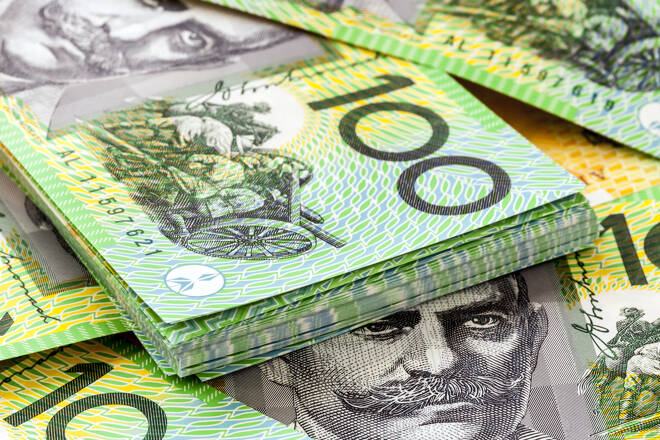Advertisement
Advertisement
AUD to USD Forecast: Can the Australian Dollar Withstand China’s Real Estate Woes?
By:
The Aussie dollar faces turbulent times as Chinese economic woes and upcoming Australian and US inflation reports will sway AUD/USD trends.
Highlights
- The AUD/USD declined by 0.25% on Monday, ending the session at $0.64231.
- China’s economic strife stirs Aussie Dollar woes.
- Later today, US CB Consumer Confidence is critical for AUD/USD trends.
Monday Overview
On Monday, the AUD/USD fell by 0.25%. Partially reversing a 0.36% gain from Friday, the Aussie dollar ended the day at $0.64231. The Aussie dollar rose to a high of $0.64467 before falling to a low of $0.64041.
Chinese Economic Woes and the Australian CPI Report
Hopes of economic reforms from Beijing turned to risk aversion on Monday. Real estate sector woes resurfaced, calling on Beijing to deliver more robust measures to address the real estate sector and the economic trajectory.
More bad news from China will adversely affect the AUD/USD trends. China accounts for one-third of Australian exports. Considering a trade-to-GDP ratio of over 50%, weakening demand from China would impact the Aussie dollar, the Australian labor market, and the Aussie economy.
While China will remain the focus today, it is inflation week for the AUD/USD pair. On Wednesday, the monthly CPI report will reveal whether the RBA can take a less hawkish rate path. Economists forecast an annual inflation rate of 5.1% in August versus 4.9% in July.
A pickup in the inflation rate would corner the RBA into taking a more hawkish interest rate path. Higher interest rates would impact the labor market and disposable incomes, forcing consumers to curb spending. A pullback in spending would ease demand-driven inflationary pressures.
Consumer Confidence in the Spotlight
The CB Consumer Confidence Index needs to hold steady to support a positive outlook on US consumption. US private consumption contributes over 65% to US GDP. Weaker consumer confidence would signal a pullback in spending, easing demand-driven inflation while adversely affecting the economy.
Economists forecast the CB Consumer Confidence Index to decline from 106.1 to 105.9. If the CB Consumer Confidence Index falls below 105, it is likely to provoke a market reaction.
Short-Term Forecast
Australian and US inflation and consumption figures will influence the near-term trajectory of the AUD/USD. However, the threat of a real estate sector collapse in China will likely keep the pressure on the Aussie dollar.
AUD/USD Price Action
Daily Chart
The AUD/USD hovered below the 50-day and 200-day EMAs, sending bearish price signals.
An AUD/USD return to sub-$0.64 would support a fall through the $0.63854 support level to target $0.63500. China will be the focal point this morning, while US consumer confidence figures will provide direction later today.
However, an AUD/USD return to $0.64500 would support a move to the $0.64900 resistance level and the 50-day EMA. Selling pressure will intensify at $0.64900. The 50-day EMA is confluent with the $0.64900 resistance level.
An RSI reading of 44.83 supports an AUD/USD fall through the $0.63854 support level to $0.63500 before entering oversold territory (typically below 30 on the RSI scale).
4-Hourly Chart
The AUD/USD sits below the 50-day and 200-day EMAs, sending bearish price signals.
A break above the 50-day EMA would support an AUD/USD move to the 200-day EMA. However, failure to move through the 50-day EMA would leave the $0.63854 support level in play,
A fall through the $0.63854 support level would give the bears a run at $0.63500.
The 14-period 4-Hourly RSI at 46.11 supports an Aussie dollar break below the $0.63854 support level before entering oversold territory.
About the Author
Bob Masonauthor
With over 28 years of experience in the financial industry, Bob has worked with various global rating agencies and multinational banks. Currently he is covering currencies, commodities, alternative asset classes and global equities, focusing mostly on European and Asian markets.
Advertisement
